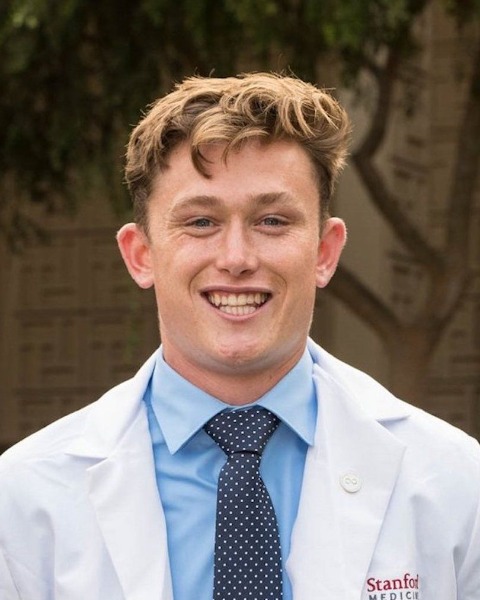Abstract Session
Abstract Session
(AS1) Comparing Laser Interstitial Thermal Therapy to Open Surgical Resection in Pediatric Tuberous Sclerosis Complex Patients: A Single-institution’s Experience
Monday, April 24, 2023
8:03am - 8:11am PST
Location: Los Angeles Convention Center, 402AB

Thomas M. Johnstone, BS (he/him/his)
Medical Student
Stanford University School of Medicine
Stanford, California, United States
Presenting Author(s)
Disclosure(s):
Thomas M. Johnstone, BS: No financial relationships to disclose
Introduction: Tuberous sclerosis complex (TSC) is a genetic condition characterized by multi-organ tuber formation. Intracranial involvement can cause medically refractory seizures requiring surgical management. Laser interstitial thermal therapy (LiTT) is a minimally invasive surgical procedure that offers an alternative to open surgical resection. Our study aimed to compare the safety and efficacy of LiTT and open resection in pediatric TSC patients with medically refractory epilepsy.
Methods: All TSC patients undergoing stereoelectroencephalography and open resection or LiTT ablation of epileptogenic foci between February 2017 and March 2022 were reviewed. Patient characteristics, operative details, medication use, seizure history, and postoperative outcomes were tabulated. A modified Engel score was used to determine seizure freedom and improvement. Nonparametric univariate pairwise analysis was conducted for all available variables between intervention groups.
Results: Ten patients underwent open resection and twenty-one patients underwent LiTT. The LiTT and open resection groups had comparable demographics, numbers of prior interventions (1.0, 1.0, p=0.733), ages at intervention (4.45, 5.11, p=0.58), numbers of anti-epileptic medications used before (2.0, 2.0, p=0.81) and following (3.0, 2.0, p=0.24) interventions, intervals between seizure onset and intervention (51 months, 52 months, p>0.9), complications (40%, 23.8%, p=0.613), postoperative seizure freedom (70%, 47.6%, p=0.433) and improvement (90%, 71%, p=0.486), and postoperative neurocognitive or behavioral improvement (60%, 66.7%, p>0.9). The length of follow-up differed between groups, as LiTT is a recent development for the surgical management of TSC (31 months, 4.6 months, p< 0.01). Patients in both intervention groups with improved postoperative seizure burden had shorter times between their seizure onset and intervention (132 months, 52 months, p< 0.01).
Conclusion : In the largest single-institution cohort of TS patients to date, LiTT and open resection had comparable postoperative outcomes. Interestingly, seizure outcomes were better in those with shorter intervals between seizure onset and operative intervention, which warrants further investigation.
Methods: All TSC patients undergoing stereoelectroencephalography and open resection or LiTT ablation of epileptogenic foci between February 2017 and March 2022 were reviewed. Patient characteristics, operative details, medication use, seizure history, and postoperative outcomes were tabulated. A modified Engel score was used to determine seizure freedom and improvement. Nonparametric univariate pairwise analysis was conducted for all available variables between intervention groups.
Results: Ten patients underwent open resection and twenty-one patients underwent LiTT. The LiTT and open resection groups had comparable demographics, numbers of prior interventions (1.0, 1.0, p=0.733), ages at intervention (4.45, 5.11, p=0.58), numbers of anti-epileptic medications used before (2.0, 2.0, p=0.81) and following (3.0, 2.0, p=0.24) interventions, intervals between seizure onset and intervention (51 months, 52 months, p>0.9), complications (40%, 23.8%, p=0.613), postoperative seizure freedom (70%, 47.6%, p=0.433) and improvement (90%, 71%, p=0.486), and postoperative neurocognitive or behavioral improvement (60%, 66.7%, p>0.9). The length of follow-up differed between groups, as LiTT is a recent development for the surgical management of TSC (31 months, 4.6 months, p< 0.01). Patients in both intervention groups with improved postoperative seizure burden had shorter times between their seizure onset and intervention (132 months, 52 months, p< 0.01).
Conclusion : In the largest single-institution cohort of TS patients to date, LiTT and open resection had comparable postoperative outcomes. Interestingly, seizure outcomes were better in those with shorter intervals between seizure onset and operative intervention, which warrants further investigation.
